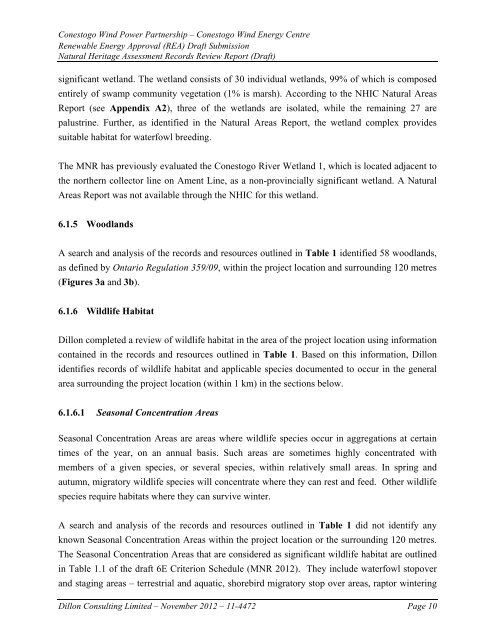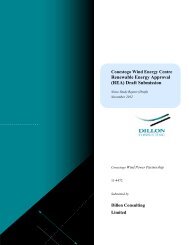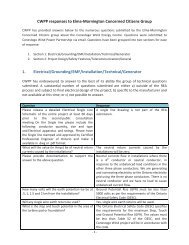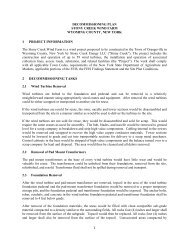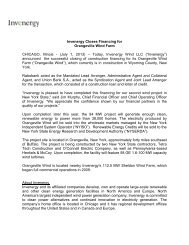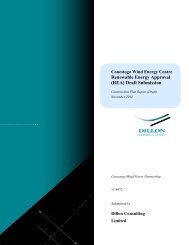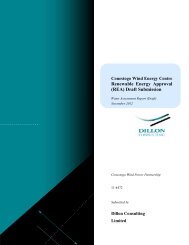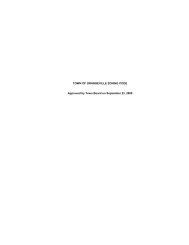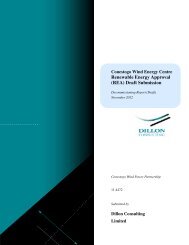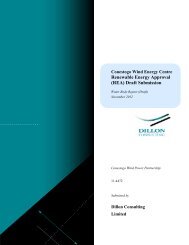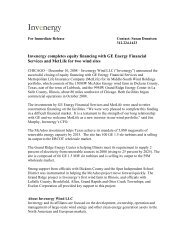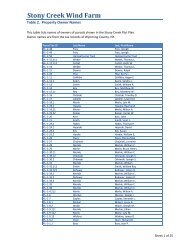Draft Records Review Report - Invenergy
Draft Records Review Report - Invenergy
Draft Records Review Report - Invenergy
Create successful ePaper yourself
Turn your PDF publications into a flip-book with our unique Google optimized e-Paper software.
Conestogo Wind Power Partnership – Conestogo Wind Energy Centre<br />
Renewable Energy Approval (REA) <strong>Draft</strong> Submission<br />
Natural Heritage Assessment <strong>Records</strong> <strong>Review</strong> <strong>Report</strong> (<strong>Draft</strong>)<br />
significant wetland. The wetland consists of 30 individual wetlands, 99% of which is composed<br />
entirely of swamp community vegetation (1% is marsh). According to the NHIC Natural Areas<br />
<strong>Report</strong> (see Appendix A2), three of the wetlands are isolated, while the remaining 27 are<br />
palustrine. Further, as identified in the Natural Areas <strong>Report</strong>, the wetland complex provides<br />
suitable habitat for waterfowl breeding.<br />
The MNR has previously evaluated the Conestogo River Wetland 1, which is located adjacent to<br />
the northern collector line on Ament Line, as a non-provincially significant wetland. A Natural<br />
Areas <strong>Report</strong> was not available through the NHIC for this wetland.<br />
6.1.5 Woodlands<br />
A search and analysis of the records and resources outlined in Table 1 identified 58 woodlands,<br />
as defined by Ontario Regulation 359/09, within the project location and surrounding 120 metres<br />
(Figures 3a and 3b).<br />
6.1.6 Wildlife Habitat<br />
Dillon completed a review of wildlife habitat in the area of the project location using information<br />
contained in the records and resources outlined in Table 1. Based on this information, Dillon<br />
identifies records of wildlife habitat and applicable species documented to occur in the general<br />
area surrounding the project location (within 1 km) in the sections below.<br />
6.1.6.1 Seasonal Concentration Areas<br />
Seasonal Concentration Areas are areas where wildlife species occur in aggregations at certain<br />
times of the year, on an annual basis. Such areas are sometimes highly concentrated with<br />
members of a given species, or several species, within relatively small areas. In spring and<br />
autumn, migratory wildlife species will concentrate where they can rest and feed. Other wildlife<br />
species require habitats where they can survive winter.<br />
A search and analysis of the records and resources outlined in Table 1 did not identify any<br />
known Seasonal Concentration Areas within the project location or the surrounding 120 metres.<br />
The Seasonal Concentration Areas that are considered as significant wildlife habitat are outlined<br />
in Table 1.1 of the draft 6E Criterion Schedule (MNR 2012). They include waterfowl stopover<br />
and staging areas – terrestrial and aquatic, shorebird migratory stop over areas, raptor wintering<br />
Dillon Consulting Limited – November 2012 – 11-4472 Page 10


